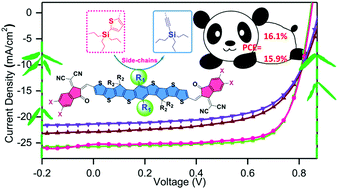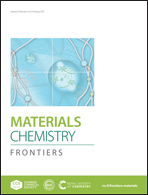Synthesizing alkynyl-decorated 2D conjugated nonfullerene acceptors for efficient polymer solar cells†
Abstract
Alkylthienyl decorated two-dimensional (2D) conjugated electron-donating (D) units such as 4,8-bis(2-alkylthienyl)benzo[1,2-b:4,5-b′]dithiophene have been widely used for designing highly efficient photovoltaic materials. However, the thienyl side chains are less involved in the backbone frontier molecular orbitals (FMOs). In this study, we replaced the side-chains from tri(n-propyl)silylthienyl to tri(n-propyl)silylethynyl and reported two alkynyl-decorated 2D conjugated narrow-bandgap (∼1.4 eV) nonfullerene acceptors, named ISI-4F and ISI-4Cl. In a striking contrast to the thienyl-linked counterpart, the ethynyl unit was significantly involved in the backbone FMOs of the new acceptor molecules, enhancing its absorptivity and reducing the energy levels. With PM6 as the donor polymer, 12.5% and 12.1% efficiencies were obtained for the acceptors. The VOC values were as high as 0.87 – 0.88 V. The tetrachlorinated acceptor supplied a larger fill factor (67.9% vs. 62.2%) with a smaller short-circuit current-density (22.8 vs. 20.5 mA cm−2) than the tetrafluorinated counterpart. When introduced as acceptor guests of PM6:Y6, 16.1% and 15.9% efficiencies were achieved. These results demonstrate that the trialkylsilylalkynyl units can be potential side-chain candidates for designing highly efficient acceptor materials.

- This article is part of the themed collection: 2021 Materials Chemistry Frontiers HOT articles


 Please wait while we load your content...
Please wait while we load your content...